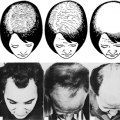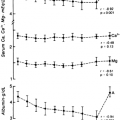EVALUATION OF THE THYROID NODULE
Single or multiple nodules of the thyroid gland are an uncommon finding in pediatric patients. Patients with nontoxic goiters may present with either solitary or multiple discrete nodules. Multinodular goiter may appear in childhood, particularly in areas in which there is chronic dietary iodine deficiency. The differential diagnosis of solitary nodules of the thyroid gland include chronic lymphocytic thyroiditis, cyst, adenoma, carcinoma, hyperplasia, toxic nodule, and embryonic defects such as intrathyroidal thyroglossal duct cysts.29 The causes of multiple thyroid nodules include toxic goiter, toxic goiter after131I therapy, chronic lymphocytic thyroiditis, and adenomatous goiter.
Nodules of the thyroid gland in children and adolescents usually are asymptomatic and are noted incidentally by the patient or parents or detected during a routine physical examination. The primary challenge is to rule out the presence of a malignancy. The appropriate evaluation and therapy for solitary or multiple nodules in pediatric patients, particularly for solitary thyroid nodules, are controversial because the diagnostic techniques used to distinguish a benign from a malignant lesion vary in reliability.
CLINICAL FINDINGS
In evaluation, the history is important and should include questions about previous irradiation of the head, neck, or upper thorax. External therapeutic irradiation of the head and neck is associated with the subsequent development of neoplastic changes in the thyroid gland.30 Also, extensive diagnostic irradiation of the head and neck of children may be a causative factor in inducing subsequent thyroid neoplasia.31 The family history should be explored for evidence of thyroid disease, pheochromocytoma, or hyperparathyroidism. Medullary thyroid carcinoma can occur sporadically or be transmitted as an autosomal dominant trait and may be associated with pheochromocytomas and hyperparathyroidism (multiple endocrine neoplasia type 2A) or can occur in association with pheochromocytoma and mucosal neuromas (multiple endocrine neoplasia type 2B) (see Chap. 188).
Information on the rate of growth of the mass, the presence of local or systemic symptoms, and hoarseness or dysphagia should be obtained. The painless, rapid growth of a nodule suggests anaplastic thyroid cancer. Pain in the thyroid gland is an uncommon symptom with malignancy. Pain is associated more commonly with a rapidly enlarging nodule caused by hemorrhage into a cyst or a benign degenerating nodule.
Stay updated, free articles. Join our Telegram channel

Full access? Get Clinical Tree





